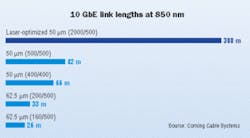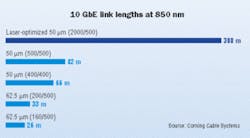If a contractor buys optical fiber wrapped in an aqua-colored sheath, can that fiber be counted on to carry a 10-Gigabit Ethernet signal for up to 300 meters at 850 nanometers (nm)?
Some industry representatives say it may not, which is causing confusion in the marketplace.
Optical-fiber cable manufacturers today are lining up on two sides of an argument regarding aqua-colored optical-fiber sheathing. Some say there is a need to raise the bar in the industry with regards to high-performance multimode optical fibers that are rated for 10-Gbit transmission speeds.
Confusion is the result, say critics, when contractors and network designers purchase laser-optimized fiber that comes in aqua-colored sheaths, and make assumptions about its bandwidth and distance capabilities.
"Not all 10-Gigabit fiber is created equal," sums Beni Blell, fiber-optic product business manager for Berk-Tek (New Holland, PA, www.berktek.com).
At the heart of the issue is the fact that multimode optical fiber has limitations in the LAN at 10-Gbit/sec transmission speeds. Not all optical fibers can carry a 10-Gbit Ethernet signal to the same distance; there is a limiting performance criteria for 50-µm multimode fiber in differential mode delay.
Manufacturers adopted three cells to guarantee minimum satisfactory performance. The first is 150 meters, the second is 300 meters, and the third is offered in 500 meters, 550 meters or 600 meters.
The cable sheaths are identified by distinct product numbers or markings on the jacket, explaining which grade of fiber is contained within. Also provided are the engineering guidelines on the limitations for each cable application, indicating the distance to which the fiber can carry 10-Gbit Ethernet.
But even with the different grades, the aqua color often remains the same. For example, SYSTIMAX Solutions (Richardson, TX, www.systimax.com) offers three grades of aqua-colored cable: LazrSPEED 150, 300 and 550. Corning Cable Systems Inc. (Hickory, NC, www.corning.com), meanwhile, places an aqua-colored jacket on optical fibers that support 10-Gbit Ethernet for up to 300 meters (LANscape Solutions Cabled Laser-Optimized 50/125 µm-300), and cables that support it for up to 150 meters (LANscape Solutions Cabled Laser-Optimized 50/125 µm-150).
Berk-Tek's GIGAlite-10 and GIGAlite -10XB, both of which have an aqua-colored jacket, guarantee a minimum distance of 300 meters and 600 meters respectively. But the company's 50-µm GIGAlite—a laser-optimized fiber with a distance of 150 meters for 10-Gbit Ethernet—has an orange jacket.
Those who say aqua-colored cabling presents a problem are calling for manufacturers to adhere to a code. Meanwhile, they are urging contractors not to buy optical fiber based on color alone, but to pay attention to the writing on the jacket if they want to know the optical fiber's precise capabilities. In other words, "If people are buying based on color and not asking further questions, they could be making the wrong assumptions," warns Paul Kolesar, distinguished technical staff, SYSTIMAX Solutions.
Those on the other side of the color argument say it's not an issue at all. Even some contractors say that what counts is not the color coding on the outside of the cable but specific communication about the capabilities of the fiber inside.
The issue has been discussed in TIA/EIA committee meetings, and a proposal for an aqua-color/fiber type association that was brought to the TIA FO-4 committee, which handles the TIA/EIA-598 standard concerning color coding, was adopted in the draft document. A few years ago, a similar proposal was discussed in TIA TR-42, but the proposal to include the color code in TIA-568 was rejected.
The TIA/EIA-598 document called for an orange jacket to indicate multimode optical-fiber cable that is used in the premises. But during the past few years, a few manufacturers adopted the aqua color for the new 850-nm laser-optimized fibers.
Lucent Technologies was the first to use an aqua-colored sheath for laser-optimized fiber, and some manufacturers followed suit. The aqua color eventually became indicative of optical-fiber cable in the LAN or SAN that is optimized for 10-Gbit/sec transmission speeds at 850 nm for up to 300 meters. In a sense, the aqua color became the de facto standard for this type of fiber.
Some manufacturers say the color coding scenario has played out almost by accident. Herb Congdon, fiber market manager for AMPNetconnect (Harrisburg PA, www.ampnetconnect.com), says other suppliers were forced to offer the aqua-colored cable when it began to sell. And they broke no laws, since standards are voluntary in the US—the TIA cannot dictate a given color choice.
"I can also offer black, purple and red (cable jackets), but if the customers are specifying that (aqua) color, the manufacturer has to offer it," says Congdon. "One customer required the aqua color in a competitive bid situation, so other suppliers were forced to offer cables with that color also."
But today, Congdon says manufacturers have an obligation to weed out confusion by making sure that contractors are not confused by a cable's color. Further, manufacturers must understand that each optical-fiber group has its own set of effective modal bandwidth.
"In a perfect world, the color of a cable jacket would tell you what fiber type you've got in your runs, without having to dig into administrators' records," says Congdon. "If you look at that color, you should be able to tell if it is 50-µm fiber, and know whatever is installed in the run. Reality, however, has to allow for local code compliance, customer preferences and manufacturer capabilities, and recognize that there is already a long history of installed cables where jacket color does not indicate the fiber type."
Blell says the issue could be resolved through the latest draft of TIA/EIA-598-C, which designated the aqua-colored laser-optimized fiber for a 300-meter minimum distance guarantee.
If the standard is approved this year, manufacturers will be encouraged to change their cable color if their cable is aqua-colored and can reach a 10-Gbit Ethernet signal for less than 300 meters. "It's just a shame that the industry did not adopt it unanimously," says Blell.

